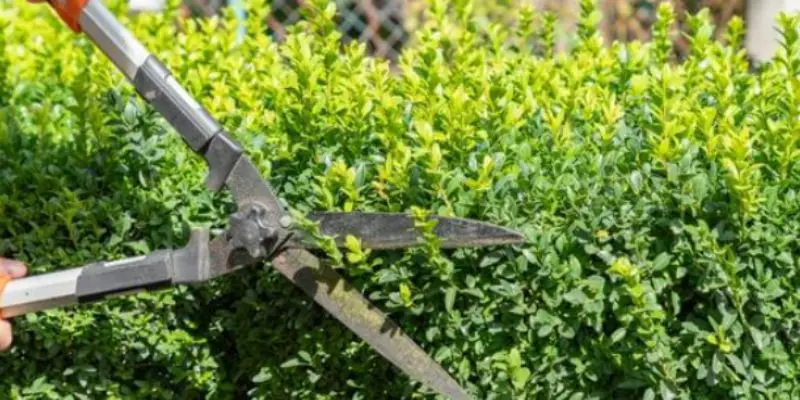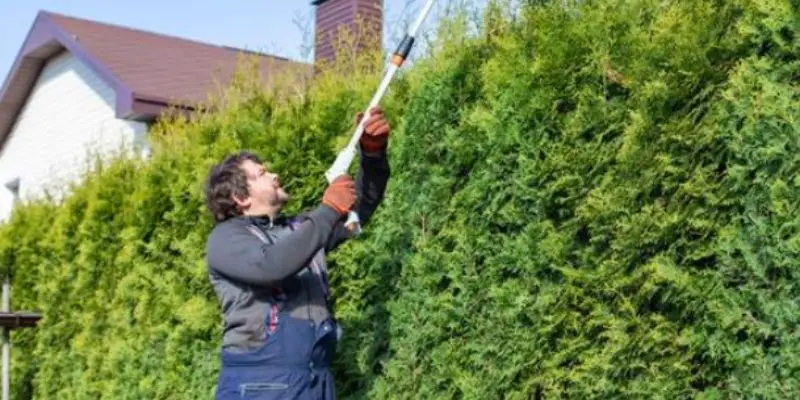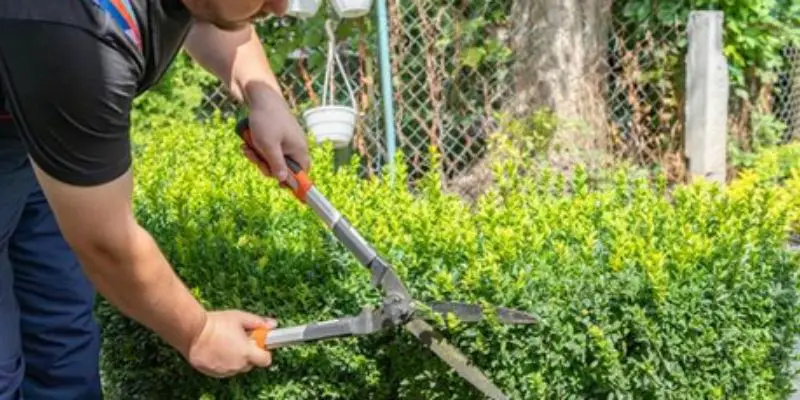Having a well-manicured yard is the ultimate goal for any proud homeowner. And when it comes to creating an outdoor oasis that’ll make your neighbors jealous, boxwood hedges are an absolute must. These lush evergreens add elegance and structure to any landscape. But here’s the catch – keeping them looking sharp requires some serious trimming skills. Don’t sweat it, though. In this guide, I’ll guide you on how to trim boxwood hedges like a pro. You’ll learn about the techniques, tools, and everything you’ll need. By the end, you’ll be ready to transform your hedge game and have the most enviable yard on the block.
Why Regular Trimming Matters
Yardwork isn’t always at the top of your to-do list. But when it comes to boxwood hedges, skipping out on regular trims is a big no-no. These babies have a naturally tidy look, but if left unchecked, they’ll quickly turn into an overgrown mess. And trust me, you don’t want that kind of chaos in your outdoor sanctuary.
Regular trimming does more than just keep things looking fly, though. It also promotes healthy growth, prevents disease, and ensures proper air flow. Think of it as a little self-care routine for your hedge. A little TLC goes a long way in keeping those evergreen beauties thriving.
Best Time to Trim Boxwood Hedges
Timing is everything when trimming boxwood hedges. The general rule of thumb is to give your boxwood hedges a good trim twice a year: once in late spring or early summer, and again in late summer or early fall. This schedule ensures your hedges maintain their fabulous shape all season long while allowing new growth to fill in any gaps or thin spots.
Of course, if you live in an area with a particularly long growing season, you may need to up your trimming game a bit. Keep an eye on your hedges and adjust your schedule accordingly. Better safe than sorry when it comes to maintaining that perfect boxwood look, am I right?
The Tools You’ll Need
Before you start trimming your boxwood hedge, you’ll need to make sure you’ve got the right tools for the job. Here’s what you’ll need to add to your gardening tools:
- Sharp Pruning Shears or Hedge Trimmers: Invest in a high-quality pair. Dull blades are a surefire way to end up with damaged foliage and a whole lot of plant stress. You want clean cuts, not tears and tears.
- Protective Gear: Trimming can be a messy business, so gear up with gloves, long sleeves, and eye protection. No one wants scratches or rogue twigs poking them in the eye, right?
- Tarp or Dropcloth: Spread one of these babies around the base of your hedge to catch any fallen trimmings. It’ll make cleanup a breeze and keep your yard looking spiffy.
- Ladder (if needed): If your boxwood hedge is on the taller side, you’ll want a sturdy ladder to reach those higher spots safely. No need to risk any DIY acrobatics, my friend.
Mastering the Art of Boxwood Hedge Design
When it comes to trimming boxwood hedges, shaping is just as important as pruning. These evergreen beauties are often used to create specific shapes and patterns in landscaping designs, adding visual interest and a touch of whimsy to your outdoor space. Here are some tips to help you become a true hedge-shaping artiste:
- Envision Your Masterpiece: Start by deciding on the desired shape for your hedge. Do you want to keep things classic with a rectangular or curved look? Or maybe you’re feeling a little more adventurous and want to try your hand at a spiral or animal shape? Once you’ve got that vision locked in, use a level or string to help you create clean, precise lines and angles.
- Trim Top to Bottom: Begin by trimming the top of the hedge first, ensuring it’s level and even across the entire length. Then, move on to the sides, shaping them into your desired form. For those curved or intricate designs, work in sections and step back often to assess the overall shape.
- Embrace the Complexity: Listen, the more complex the shape you’re creating, the more maintenance it’s going to require to maintain that form. Simple, clean lines are often easier to upkeep and can give your outdoor space a sleek, streamlined look. But hey, if you’re up for the challenge of maintaining an intricate design, go for it! Just be prepared to put in a little extra elbow grease.
How to Trim Boxwood Hedges Like a Pro: Essential Techniques for Healthy Hedges
While shaping is a key part of boxwood hedge trimming, proper pruning techniques are equally crucial for keeping your hedge healthy and happy. Here are some essential tips to keep in mind:
- Use Sharp, Clean Tools: Always, always use clean, sharp pruning shears or hedge trimmers. Dull blades can tear and damage the foliage, leaving your hedge vulnerable to disease and pests. Make clean, precise cuts to promote healthy growth and prevent any unnecessary plant stress.
- Remove Dead or Crossed Branches: As you trim, be sure to remove any dead, damaged, or crossed branches from the inside of the hedge. This will improve air circulation and light penetration, keeping your hedge in tip-top shape. But be careful not to over-prune – removing too much foliage at once can put a lot of stress on the plant.
- Maintain a Tapered Shape: When shaping your boxwood hedge, aim for a slight inward taper from top to bottom. This tapered shape allows sunlight to reach those lower branches, preventing the hedge from becoming too dense and promoting even growth throughout.
Top 5 Best Black and Decker Cordless Hedge Trimmer Reviews
Boosting Curb Appeal with Perfect Hedges
One of the main reasons homeowners choose to incorporate boxwood hedges into their landscaping is the serious curb appeal factor. A well-trimmed, neatly shaped hedge can instantly elevate the look of your outdoor space and give it a polished, sophisticated vibe. Here are some tips to help you maximize the curb appeal of your boxwood hedges:
- Symmetry Is Key: Pay close attention to the overall symmetry and balance of your hedge as you trim. Asymmetrical or lopsided hedges can throw off the whole look you’re going for. Use a level or string guide to ensure even lines and angles, creating a cohesive, visually appealing shape.
- Incorporate Into a Larger Design: Consider incorporating your boxwood hedges into a larger landscaping design. For example, you could use them to create a beautiful border around your garden beds or line a walkway, adding structure and definition to your outdoor space.
- Attention to Detail: Don’t forget to maintain the area around your boxwood hedges, too. Keep the surrounding grass neatly trimmed, and consider adding mulch or decorative rocks to create a polished, well-manicured look. It’s all about those little details, my friend.
Cleanup and Aftercare: Keeping It Fresh
Once you’ve completed the trimming process, it’s time to tidy up the area. Carefully gather any fallen trimmings from the tarp or dropcloth and dispose of them properly. Depending on the size of your hedge, you may need to repeat this step a few times to ensure a clean workspace.
After the trimming and cleanup are complete, give your boxwood hedge a good, deep watering. This’ll help reduce stress on the plant and encourage new growth. You can also consider applying a balanced fertilizer or compost around the base of the hedge to replenish any nutrients that may have been lost during the pruning process.
Maintaining a Healthy Boxwood Hedge: Tips for Long-Term Success
Regular trimming is key for keeping your boxwood hedge looking its best, but it’s equally important to ensure the overall health of the plant. Here are some tips to help you maintain a thriving hedge for years to come:
- Proper Watering: Boxwood hedges thrive in well-draining soil but still require consistent moisture. During dry spells or heat waves, be sure to water your hedge deeply and regularly to prevent drought stress.
- Mulching: Applying a 2-4 inch layer of organic mulch around the base of your hedge can work wonders. It’ll help retain moisture, suppress weeds, and provide essential nutrients as the mulch decomposes over time.
- Pest and Disease Management: Unfortunately, boxwood hedges can be susceptible to certain pests and diseases, like boxwood leaf miner, boxwood blight, and root rot. Regularly inspect your hedge for any signs of trouble, and take appropriate action if necessary. Don’t be afraid to consult a professional arborist or horticulturist for guidance.
- Winter Protection: If you live in a colder climate, your boxwood hedge may need a little extra TLC during those harsh winter months. Consider wrapping the hedge in burlap or applying an anti-desiccant spray to prevent moisture loss and damage from freezing winds.
When to Call in the Pros
Although you can easily learn how to trim boxwood hedges, there may be times when hiring a professional is the way to go. Let’s take a look at a few scenarios where enlisting the help of an expert might be wise:
- Complex or Intricate Designs: If you’ve got a particularly large or intricate hedge design, it may be best to leave the trimming to the pros. Professional landscapers have the experience and equipment to handle those complex shapes and patterns with precision and expertise.
- Limited Time or Physical Ability: We all lead busy lives. If you’re short on time or simply don’t have the physical ability to properly trim your boxwood hedges, hiring a reputable landscaping company or arborist can take that burden off your plate. They’ll ensure your hedges are trimmed correctly and on a consistent schedule, without compromising their health or appearance.
- Seeking Expert Guidance: Not sure about the proper techniques for trimming or maintaining your boxwood hedges? No sweat! Seeking professional guidance from a knowledgeable arborist or horticulturist can be a game-changer. They’ll provide expert advice on pruning, pest management, and overall plant care, ensuring your hedges stay in tip-top shape for years to come.
Conclusion
Mastering the art of trimming boxwood hedges is a skill that’ll pay dividends in creating a stunning and inviting outdoor space. By following the techniques outlined in this guide on how to trim boxwood hedges, using the proper tools, and maintaining a regular pruning schedule, you can ensure your boxwood hedge remains a true showstopper.
Remember, a well-manicured hedge not only enhances your home’s aesthetic appeal but also contributes to the overall health and longevity of the plant. Whether you choose to tackle the task yourself or enlist the help of a professional, taking the time to properly trim and care for your boxwood hedge is an investment that’ll keep paying off for years to come.
With patience, attention to detail, and a deep understanding of the plant’s needs, you can transform your outdoor oasis into a true masterpiece, with perfectly pruned boxwood hedges as the focal point. So, what are you waiting for? Grab those pruning shears, put on your gardening gloves, and get trimming!
Also read:
Best Electric Hedge Trimmer – Top 5 Picks and Buying Guide

Michael Glenn is a certified arborist and horticultural expert with over 15 years of experience in the landscape industry. His passion for plants and trees has led him to become a sought-after authority on pruning and trimming techniques. Glenn’s in-depth knowledge of proper pruning methods, timing, and tools has helped countless homeowners and professionals maintain healthy, aesthetically pleasing gardens and landscapes.
In addition to sharing his pruning expertise through practical tips, step-by-step guides, and expert advice, Glenn is also a respected author of pruning tool buying guides. His comprehensive reviews and comparisons ensure readers can make informed decisions when investing in quality loppers, pruning shears, saws, and other essential equipment. With a deep understanding of plant biology and sustainable practices, Glenn’s writing empowers audiences with the knowledge needed to properly care for green spaces.




